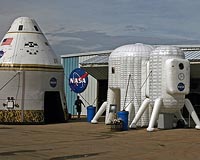 |
Bonn, Germany (SPX) Aug 03, 2009 New noise abatement approach trajectories for conventional transport aircraft have been tested in flight by the German Aerospace Center. The trajectories under consideration promise ground-noise reduction along most of the flight path by relocating and concentrating high noise levels into selected areas. A new, high-precision autopilot for automated flight operation was installed onboard the test aircraft and operated in flight. These tests were accompanied by a dedicated noise measurement campaign to record the noise impact along the ground track of each flight procedure. In addition, the integration of the new procedures into conventional air traffic management was monitored from the airport's control tower. The campaign was organised and operated by DLR in close cooperation with the Institute of Aeronautics and Astronautics (Institut fur Luft- und Raumfahrt; ILR) at the Rheinisch-Westf�lische Technische Hochschule (RWTH) Aachen University, and the German Air Traffic Control Service, Deutsche Flugsicherung GmbH (DFS). At DLR, a new simulation process was established for the environmental analysis of aircraft configurations. The process was applied to develop new approach trajectories for ground-noise reduction. A helical flight segment was implemented into a conventional approach path. Due to its shape, the new trajectory is referred to as a 'Helical Noise Abatement Procedure' (HeNAP). The flight path prior to the helical segment is shifted to higher flight levels; hence noise impact on the ground is reduced. High noise levels are relocated and concentrated within the area under the helix. Obviously, this limited area is exposed to increased noise levels. The noise concentration under the helical flight segment effectively reduces ground noise levels along the entire preceding flight path.
Flight test of the new autopilot along selected approach trajectories This autopilot allows for fully automated and highly accurate tracking of flight trajectories, including HeNAP. Helical Noise Abatement Procedures are very challenging flight procedures even under constant wind conditions. Therefore, this application is a benchmark test of the autopilot's performance. The dedicated ground noise campaign was organised by the DLR Institute of Aerodynamics and Flow Technology (Institut fur Aerodynamik und Stromungstechnik) in close cooperation with ILR at RWTH Aachen University. The necessary technical equipment for the noise measurements was provided by ILR. The air traffic controller workload and the air traffic integration of the new procedures were monitored by DFS.
Validation of the predicted ground noise distribution along the helical approach path Initial analysis of the noise data confirms the predicted relocation and concentration of high noise levels along only the helical flight segment. Along the flight path prior to the helix, the anticipated ground noise reduction was achieved. Due to the helical flight segment, fuel consumption and flight time would increase to some degree. Obviously, a trade-off between a significant noise reduction and increased fuel consumption and flight time becomes inevitable. Share This Article With Planet Earth
Related Links DLR Institute of Aerodynamics and Flow Technology DLR Institute of Robotics and Mechatronics Aerospace News at SpaceMart.com
 EAA AirVenture: An Aviator's Dream World
EAA AirVenture: An Aviator's Dream WorldOshkosh WI (SPX) Aug 03, 2009 Aviation enthusiasts seek out certain destinations. There are Paris and Farnborough for the big international crowd, Kill Devil Hills, N.C. for the historians and Oshkosh, Wisc., for those who crave a look at aircraft that are a little different. For a week every summer a small airfield in central Wisconsin is an aviator's dream world. It's been that way for more than half a century, since ... read more |
|
| The content herein, unless otherwise known to be public domain, are Copyright 1995-2009 - SpaceDaily. AFP and UPI Wire Stories are copyright Agence France-Presse and United Press International. ESA Portal Reports are copyright European Space Agency. All NASA sourced material is public domain. Additional copyrights may apply in whole or part to other bona fide parties. Advertising does not imply endorsement,agreement or approval of any opinions, statements or information provided by SpaceDaily on any Web page published or hosted by SpaceDaily. Privacy Statement |